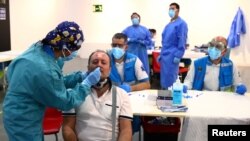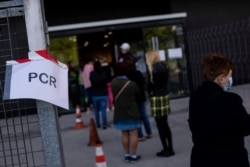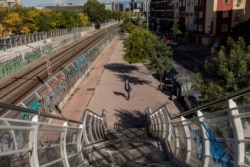Millions of Madrileños were preparing to go into lockdown once again Thursday as authorities in Western Europe's worst hotspot shut down the Spanish capital to try to halt a new surge in COVID-19 cases.
The Spanish government gave regional authorities 48 hours to comply with new restrictions which will affect this city of more than 3 million people and nine surrounding communities.
Isabel Díaz Ayuso, the head of Madrid's city government, said regional authorities will abide by the order but will challenge the Spanish government in the courts, widening a rift between her conservative regional administration and the minority left-wing coalition central government.
Other regions such as Catalonia, Andalusia and Galicia have also opposed the new restrictions.
Madrid authorities say the lockdown will damage the economy of the Spanish capital which thrives on its bars, restaurants and — in normal times — tourists.
The dispute has been widely criticized by health workers and epidemiologists who say the bickering has hindered attempts to save lives in Europe's worst-hit city.
Spain, with the highest infection rate in the European Union, has reported 300 coronavirus cases per 100,000 inhabitants during the past two weeks.
Madrid, where over a third of all Spain's cases have been recorded, reported 735 cases per 100,000 people.
By Thursday, Spain had recorded 769,188 cases — the highest in Western Europe — and 31,791 deaths.
Efforts wane
As the pressure on the city's hospitals and health centers has mounted, doctors said authorities have given up its track and trace program.
"They have left us to our own fate," Angela Hernández, vice president of the Madrid Doctors Association, told VOA.
She said track and trace teams in Madrid have stopped trying to reach people who have tested positive for COVID-19, including school children and any family or friends.
"With no track and tracing, it means this can only get worse even if they close down the city," said Hernández.
"The politicians should have used this moment to help the public regardless of political differences. ... Instead, they just want to perpetuate their own positions."
The new curbs will apply to Madrid, with a population of over 3 million, and nine surrounding municipalities with populations of at least 100,000 each.
Borders will be closed to outsiders for non-essential visits, with only those traveling for work, school or medical visits allowed to cross. Bars and restaurants will be subject to a curfew between 11 p.m. and 1 a.m. Residents will not have to stay at home, as happened during the state of emergency in March, but can move around their own areas.
Protests
Ayuso agreed to abide by the lockdown order but said the battle was not over.
"Madrid is not in rebellion. We will obey them but we will go to court to oppose them. This plan destroys Madrid," she said.
A partial lockdown has already been imposed in many of the poorer areas of Madrid with high infection rates, prompting demonstrations.
Protesters said they felt marginalized by the conservative authorities who were putting jobs at risk.
"It is OK for me to travel to Salamanca to serve at the tables of the rich, but they put restrictions on my area where I live," said Gema Ordoñez, a waitress who works at a cafe in one of the most exclusive areas of Madrid and lives in Vallecas, an area placed under partial lockdown.
"Many people where I live do not have jobs with contracts. If they have to stay at home because someone has tested positive for the virus, they will lose their jobs."
Rafael Bengoa, a former World Health Organization director and one-time adviser to U.S. President Barack Obama, said shutting down Madrid was the only option.
"Imposing partial lockdowns does not work. There is community transmission so it means a total lockdown must happen," he told VOA.
Echoes of a bitter past
The bitter political fighting evokes dark memories and raises alarms in a nation that has yet to fully heal from a 1936-1939 civil war between forces on the left and right that resulted in the deaths of an estimated half-million people.
Jason Webster, the author of Violencia which tells the history of Spain's violent past, said: "Sadly, what's happening now in Madrid — the petty point-scoring, politicians caring more about damaging their opponents than actually serving the people who elected them — is nothing new.
"People are used to it, but the damage lingers and festers until seemingly out of nowhere there comes an explosion. Only time will tell whether that will happen again."











